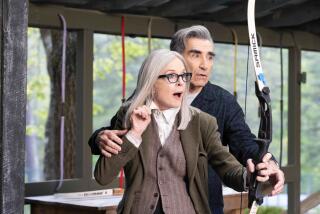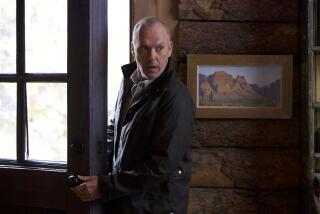Marion Mack--the Girl in Buster Keaton’s Epic
- Share via
Her acting career was short--just seven years--but thanks to a bit of serendipity and a quick-thinking hairdresser, Marion Mack’s name has earned a spot in Hollywood history.
It was 1926, and silent film comedian Buster Keaton was looking for a leading lady with long, dark curls to star with him in his next feature, a comic spin on the true story of a Civil War locomotive chase. Hairdresser Percy Westmore thought of Mack, and set up an interview for her.
But when he told the actress about the role, her heart sank--she had cut her hair short that day. Her chance to work with one of the biggest stars in Hollywood appeared to be ruined.
Westmore came up with a solution: Working against the clock, he created a long fall to replace Mack’s lost locks. She passed the audition, got the job and--to avoid discovery--brought her own hairdresser on location. The film was “The General,” which came to be regarded as Keaton’s masterwork and one of the classics of the silent era.
Mack--who goes by her real name, Joey Lewyn, these days--is reminded often of her role in “The General.” In the 1970s and early 1980s, she traveled all over the world to appear at public screenings of the film. She is 85 now and unable to travel from her Costa Mesa home because of a heart condition, but she shares her memories of the filming as part of “Buster Keaton: A Hard Act to Follow,” a three-part profile being shown on PBS stations later this month as part of the “American Masters” series.
Lewyn’s rise to screen success was the stuff of Hollywood fantasy. It began when she was a starstruck teen named Joey Marion McCreery in the tiny town of Mammoth, Utah.
“I wrote a letter to Mack Sennett and sent some snapshots of me in a bathing suit, and I was very surprised when I got a letter back,” Lewyn recalled in an interview at her home. “They said if I ever came to Hollywood--properly chaperoned--they would interview me.”
Her father and stepmother took her to Hollywood in April, 1920, just after her 18th birthday. “I went over to Mack Sennett’s studio and they gave me a job right away at $25 a week,” Lewyn said. “Mabel Normand had been the star there, and Mack Sennett thought that I looked a little bit like Mabel, and I think that was one reason I got the job.”
She became a member of Sennett’s “Bathing Beauties,” a troupe of shapely young ladies who appeared in many of the slapstick king’s comedy shorts. “The Mack Sennett girls were, at that time, frowned on a little bit,” Lewyn admitted. “Of course, we weren’t near as decollete as they are today in their bathing suits--we wore one-piece suits--but it was a little naughty to work at Mack Sennett’s as a bathing girl.”
Lewyn stayed just three months before moving to Mermaid Pictures where she worked in comedy shorts for $100 a week. Later she worked in Westerns at Universal, returning briefly to Mermaid after a year.
From there she went into her first feature, writing and starring in “Mary of the Movies,” based loosely on her own experiences in Hollywood. It was then that she first took the name Marion Mack; it also was the first time she worked with her future husband, producer Louis Lewyn.
“Mary of the Movies” was a success, and Mack went on to star in the features “Carnival Girl” and “One of the Bravest” before landing the role in “The General.”
Clyde Bruckman, a Keaton associate, had seen comic potential in “The Great Locomotive Chase,” a book based on an actual Civil War incident. Keaton--who was riding a string of successful features including “Our Hospitality,” “Sherlock Jr.,” “The Navigator,” “Go West” and “Battling Butler”--took the bare outline of the story and created a masterpiece.
With its elaborate comic vignettes and sometimes breathtaking stunts, its visual sweep and attention to historical detail (Keaton modeled the film’s look after Matthew Brady’s Civil War photographs), “The General” has taken its place alongside Chaplin’s “The Gold Rush” as one of the silent era’s great comic epics.
In the film, Keaton played railroad engineer Johnnie Gray, who has two loves: his train, the General, and Annabelle Lee, played by Marion Mack. The General is stolen with Annabelle Lee aboard; Keaton, on his own, takes another locomotive and goes after them. A long chase ensues from South to North, and back again when Keaton recaptures the General behind enemy lines.
The film climaxes with a dramatic battle scene and the single most expensive shot in silent film history: a real locomotive plunging spectacularly through a burning bridge into the river below.
Mack spent six months on the film, five months of location shooting in Oregon and one month of studio work. The sprawling production involved hundreds of extras, drawn from the Oregon National Guard, and many difficult shots (most of the action takes place aboard moving trains).
“There was a lot of excitement going on there” with the location shooting, recalled Lewyn, who found Keaton an easy director to work for (“Everybody loved Buster,” she said) and a lover of mischievous pranks-- nothing like his on-screen “Great Stone Face” persona.
“Buster was always playing jokes on everybody--practical jokes.” Lewyn said that once after returning from a swim, she found all her clothes tied together.
In an episode she relates in the PBS documentary, one practical joke made it onto the screen. She and Keaton were on top of a tender car at a water tower when a forceful blast of water bowled her over. “I didn’t know they were going to do that,” Lewyn said. “I wasn’t expecting it so it made a very good scene, but if it had been talkies they’d have cut it out because I was so mad at them.”
Lewyn was prepared by her background in slapstick films for the physical nature of Keaton’s humor.
“He tended to regard all his leading ladies as props,” says film historian David Gill, co-writer and co-producer with Kevin Brownlow of the PBS Keaton profile. “He didn’t show an interest in exploring the emotional aspects of the character.”
When “The General” premiered in New York, Lewyn said, it played next door to “The Jazz Singer,” the first successful talkie. “The General” was moderately successful, but because it was so expensive to make it lost money. The studio began tightening up on Keaton, and his career began to decline. He died in 1966, not long after he was rediscovered by a new generation of film fans.
Mack, meanwhile, acted in one more film (“Alice in Movieland”) before retiring to write scripts for her husband. Louis Lewyn spent most of his career producing “magazines of the screen,” short humorous vignettes built around popular stars of the day.
Very much a part of the heady Hollywood scene, the Lewyns owned three Rolls-Royces and shared a seven-acre Beverly Hills estate near the homes of John Barrymore and Mary Pickford. Through their film work, they knew most of the stars of the day; she counted Clara Bow and Rudy Vallee among her best friends.
And though she never again acted with Keaton, their paths did cross a few more times.
Once, Keaton and a band of his Hollywood friends paid a visit to the Lewyns only to find that they had gone off on a trip. Undeterred, Keaton and company stayed for three days, running the servants ragged, raiding the liquor cabinet and leaving the house a mess.
And later, Keaton played a brief role in one of the Lewyns’ short subjects, “Fiesta at Santa Barbara,” which also included the film debut of a young girl named Frances Gumm, soon to change her name to Judy Garland. “My husband showed it to MGM, they signed her up and of course we know the rest of the story,” Lewyn said.
Short-subject films went out of favor in the 1940s. At the same time, Louis Lewyn’s health began to decline, and in 1949 Joey Lewyn left the world of film and entered real estate. She enjoyed a successful second career, and in 1960 the couple moved to booming Orange County. Louis died in 1969.
About a year later, Joey got a call from film collector Raymond Rohauer who wanted her to travel with “The General.” She had no idea at the time, she said, that people would remember her, but she ended up touring throughout the United States, Europe and even the Middle East.
“I was kind of tired of working in real estate anyway,,” she said, “so I enjoyed going back to traveling with the movie and being an actress again. I really had a wonderful break because all my life I wanted to travel, and I never could have afforded as much as they spent.”
She began to be interviewed for books and television shows. Gill and Brownlow first interviewed her in London in the 1970s for their 13-part series “Hollywood.” They came to Costa Mesa last year to tape an interview for their Keaton piece.
They had hoped to find rushes and outtakes from Keaton’s films, as they had for their “Unknown Chaplin” series, but they only could find production stills. So the opportunity to interview such co-workers as Lewyn became essential.
“They’re vital elements, they’re flesh,” said Gill. “Not many of (Keaton’s) co-workers are still alive to talk to. . . . We’re very aware that we’re 10, 20 years too late. Even when we made the ‘Hollywood’ series 10 years ago, we were too late.”
Still, he feels that they were able to capture some of Keaton’s essence. “People (who have seen the profile) have reacted very warmly to Keaton the man,” Gill said. “While we didn’t have the rushes, the combination of the witnesses and the stills actually gives us a new dimension.”
Lewyn, for her part, is pleased that people remember “The General”--and remember her. “I still get about seven fan letters a week,” she said while showing a visitor publicity photos that she keeps in a large scrapbook. “I get them from Germany and all over.”
Lewyn rarely ventures out to theaters but often watches movies on TV and admitted that she is put off by the levels of sex and violence in some of today’s films--”not,” she said, “that I’m a prude, but you just get tired of it.” She finds the continuing popularity of “The General” encouraging and “refreshing because there’s nothing in ‘The General’ that can’t be seen by the most religious person,” she said. “I used to say in my appearances that it was an international language, that everybody could understand the comedy in this movie.”
Parts one and two of “Buster Keaton: A Hard Act to Follow” will be shown Friday at 10 p.m. on KCET, Channel 28, and will repeat Nov. 26 at 4 p.m. Part three will air Nov. 25 at 10:30 p.m. and will repeat Nov. 27 at 5 p.m. All three parts will air on KOCE, Channel 50, on Nov. 28 at 10:30 p.m.
More to Read
Only good movies
Get the Indie Focus newsletter, Mark Olsen's weekly guide to the world of cinema.
You may occasionally receive promotional content from the Los Angeles Times.










